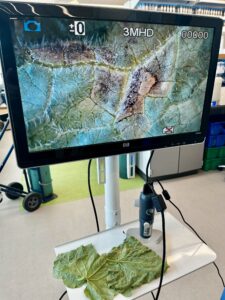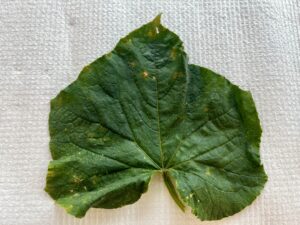Cucumber Downy Mildew Found in Sampson County in North Carolina
go.ncsu.edu/readext?1007383
en Español / em Português
El inglés es el idioma de control de esta página. En la medida en que haya algún conflicto entre la traducción al inglés y la traducción, el inglés prevalece.
Al hacer clic en el enlace de traducción se activa un servicio de traducción gratuito para convertir la página al español. Al igual que con cualquier traducción por Internet, la conversión no es sensible al contexto y puede que no traduzca el texto en su significado original. NC State Extension no garantiza la exactitud del texto traducido. Por favor, tenga en cuenta que algunas aplicaciones y/o servicios pueden no funcionar como se espera cuando se traducen.
Português
Inglês é o idioma de controle desta página. Na medida que haja algum conflito entre o texto original em Inglês e a tradução, o Inglês prevalece.
Ao clicar no link de tradução, um serviço gratuito de tradução será ativado para converter a página para o Português. Como em qualquer tradução pela internet, a conversão não é sensivel ao contexto e pode não ocorrer a tradução para o significado orginal. O serviço de Extensão da Carolina do Norte (NC State Extension) não garante a exatidão do texto traduzido. Por favor, observe que algumas funções ou serviços podem não funcionar como esperado após a tradução.
English
English is the controlling language of this page. To the extent there is any conflict between the English text and the translation, English controls.
Clicking on the translation link activates a free translation service to convert the page to Spanish. As with any Internet translation, the conversion is not context-sensitive and may not translate the text to its original meaning. NC State Extension does not guarantee the accuracy of the translated text. Please note that some applications and/or services may not function as expected when translated.
Collapse ▲Pseudoperonospora cubensis is responsible for cucurbit downy mildew (CDM), which was detected in Sampson County on cucumbers on June 4, 2024, with a disease incidence of around 5%.
On the upper side of the leaves, chlorotic lesions were noted (Figure 1), while the underside exhibited the characteristic dark sporulation of CDM (Figure 2). These observations align with the typical symptoms and signs of the disease. Microscopic examination confirmed the presence of sporangia, the microscopic structures of P. cubensis, on the underside of the leaves. P. cubensis consists of two clades, each with host preference among cucurbit crops. In North Carolina, Clade 2 targets cucumbers and cantaloupes, while Clade 1 prefers watermelon, squash, and pumpkin. Currently, cucumber and cantaloupe crops are particularly vulnerable to CDM due to the arrival of Clade 2 isolates in North Carolina via air currents. Growers of these crops are strongly advised to take immediate protective measures using effective downy mildew fungicides.
Given the potential for P. cubensis to develop resistance to fungicides, it is essential to implement a robust spray program that alternates fungicides with different modes of action and includes protective chemistries. This approach reduces the risk of resistance. Annual fungicide efficacy trials in North Carolina have demonstrated differences in effectiveness between the two clades. Therefore, consult our cucurbit downy mildew fact sheet for information on effective chemistries for your specific crops.

Figure 2: Microscopic examination of the underside of the leaf showing dark sporulation (Photo credit: Lina Quesada)
If you suspect downy mildew in your crops, contact your local Extension Agent. You can send physical samples or photos to the Plant Disease and Insect Clinic. Upon confirmation, consider anonymously reporting to the Cucurbit downy mildew IPMpipe website. Managing CDM is a community effort due to its ability to spread over long distances via wind currents. Both growers and homeowners should regularly inspect cucurbit leaves for signs of downy mildew.
Register with the CDM IPM PIPE to receive alerts via text, email, or phone when new disease outbreaks are reported nearby. Follow us on X for more updates on vegetable disease alerts.



